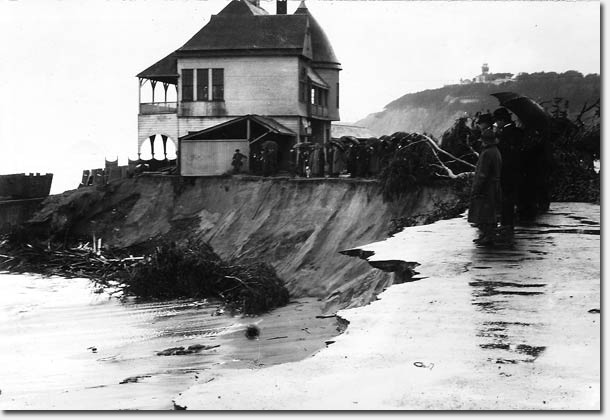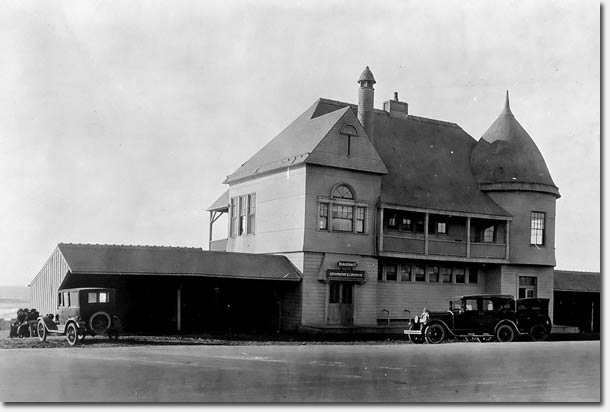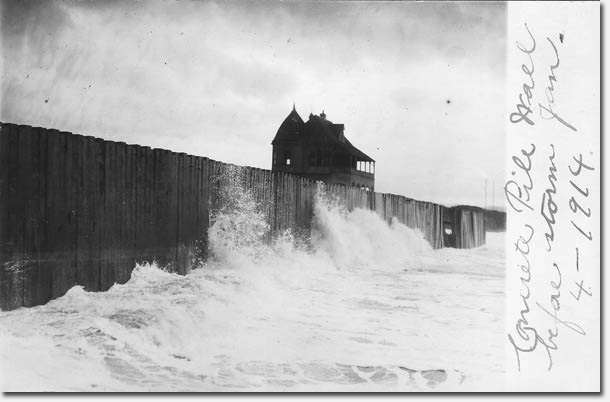
Crowds turn out to see if the original Beach Chalet can survive a winter storm and
eroding Ocean Beach, 1914. Courtesy outsidelands.org
Most of you have probably been to the Beach Chalet at least once over the years; it’s a neighborhood landmark that has been there since 1925.
But I didn’t know – until I got my Western Neighborhoods Project newsletter in April – that there was an original Beach Chalet just across the road, right on the beach. But combine some precarious, eroding cliff with harsh weather conditions, and it was not destined to last.
In the article below, Richmond District historian John Freeman details the beginnings of the original Beach Chalet, originally known as “The House on the Beach”, its battle with the elements, and its final evolution from the cliffs of Ocean Beach to becoming a Boy Scout clubhouse in the Sunset District.
Special thanks to John and Woody LaBounty of the WNP for sharing this. If it weren’t for them, this kind of neighborhood history would slip away. Want to support their efforts? Consider a WNP membership.
The odyssey of the original Beach Chalet
by John Freeman
The Beach Chalet on San Francisco’s Great Highway dates back to 1925, but few people know there was a predecessor chalet that stood directly across from the current location, on the sand west of the highway. That original Beach Chalet had a fascinating history, first perched on the beach, and after, when it was moved twenty-five blocks east to serve as a clubhouse for the Sunset District Boy Scouts.
As Golden Gate Park developed in the 1870s, most of the landscaping and public structures were concentrated at the eastern end, near Stanyan Street. There were dirt roads leading out to the western end of the park and Ocean Beach, but little planting and no public structures for those who took carriage or bicycle rides to see the surf. There was the Cliff House on the bluff, and at its base, a roadhouse called the Seal Rock House, and next door the Ocean Beach Pavilion for dancing. All these early building were more associated with entertaining adults than providing genteel recreation for families.
In November 1891, the Park Commission let contracts for $8,000 to construct a building designed by architect William O. Banks to serve as shelter from the wind, provide bathrooms and changing rooms for bathers, and offer observation decks to watch the waves on one side and the developing park on the other. As the San Francisco Chronicle said, “it will be an elegant addition to the few structures which at present relieve the monotony of sand dunes.”
The new “House on the Beach” opened on Sunday, March 20, 1892. The building was described as “a two-story structure having steep roofs with ornamental gables in Queen Anne style.” There were towers at each end of the building, one of which contained a staircase leading to the second or “observation” floor. “This is divided into a large lounging room, a reading room and toilet and dressing room for women,” the Chronicle noted, making no mention of facilities for the men. One can only assume men were also provided a room for changing into their woolly swimming attire. The newspaper description continues:
- The entire seaward side of the building is utilized as an observation platform and supplied with basket-shade chairs, stools, etc. On the landward side between the towers is located another platform, also well equipped with chairs. The building is designed especially for accommodation of ladies with children who wish to avoid the crowds at the Cliff House.

The Original Beach Chalet was built in 1892 on the west side of the Great Highway
across from Golden Gate Park. Courtesy outsidelands.org
In the early years, there was no clear identity for “The House on the Beach;” it was sometimes also called “The Observatory.” By 1895, there were newspaper references to Chalet Beach at the end of Golden Gate Park, and the building there seemed to have developed a permanent identity, but not a firm foundation. The Beach Chalet got little notice in the press, except for the annual reports to the Park Commission, which listed revenue from food concessions at the Chalet and Sharon Lodge at the Children’s Playground in the same category. The Chalet served “approved” refreshments, not alcoholic beverages, since that would be out of character for a building “designed especially for ladies with children.”
After the 1906 earthquake, the Chalet was mentioned in the park superintendent’s report on damage to structures in the park, and $2,000 was requested for unspecified repairs, most likely to stabilize the foundation. The location of the structure provided wonderful views and a comfortable place to get out of the wind; yet a building situated on the beach was constantly subject to the encroaching waves, especially during winter storms.
By 1909, the Park Commission approved a plan to build a 300-foot breakwater to protect the Chalet and the Great Highway. The area just north of the building, near Fulton Street, was determined to be where the ocean tides formed the strongest eddy, a severe threat to the building and the highway. The plan was to separately pour thirty-foot concrete pilings and, when the pilings were cured, sink them into the sand, fifteen feet deep, and place them side by side to form a bulkhead, lashed together with railroad ties. In addition, large rock rubble would be placed in front of the pilings, with concrete poured to keep it all stable and hopefully deflect the waves. The first phase of the work was done in 1910. The entire seawall was completed in 1911.
The real test of the seawall came in January 1914… Read the full article at outsidelands.org

The city erected a concrete pile sea wall to try and protect the original Beach Chalet
from the waves. Courtesy outsidelands.org
Fantastic. Thank you for this… the History of the Dunes is a relic to most San Franciscans. That outside lands site is boffo…. check out “Carville”. It’s mind blowing the sort of bohemian culture that existed in that wasteland of sand and mist. Love it. Cheers!
Great photos! Thanks for sharing.
Very cool, thanks for posting! Love WNP.